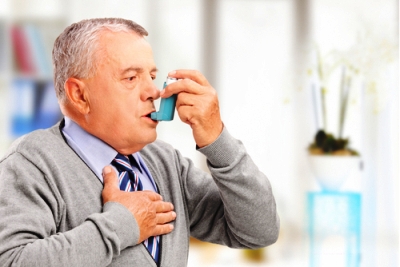Device Technique: A Forgotten Factor in Therapy Adherence
Posted on April 05, 2019 |
 This post was authored by Mike Hess, RRT, RPFT.
This post was authored by Mike Hess, RRT, RPFT.
Imagine if you will, you’re seeing one of your folks with COPD. Inpatient, outpatient, doesn’t really matter. You’ve seen Mr. or Mrs. X more often than you should have over the past few months. No matter what you do, they keep coming back to your office (or worse, heading to the emergency department) with uncontrollable shortness of breath. You ask them if they’re using their inhaled medications and they tell you, “Yes, of course.” You’ve heard that before, but a quick check of the counter seems in line with at least most of the expected doses. You’ve run through pretty much the whole gamut of meds in the desired class, so now what? There’s nothing left, right? Maybe this is just where they’re going to live from now on.
Or maybe not. Although many people have an idea of inhalers being easy-to-use medication delivery systems because that’s usually what they see on TV, anyone who has ever had to use one (or teach one) knows that’s simply not true. Inhaler technique is a learned skill, no different from driving a car or riding a bicycle (or typing a blog entry). Like many other skills, use of an inhaler is not necessarily mastered quickly or without practice; however, if we truly hope to be effective in helping our patients live their best lives, we must start taking more time to evaluate their technique and guide them toward mastery.
Therein lie a couple of problems. First, we don’t always know what the best technique is. As a respiratory therapist, I’m quite sure I was taught all the steps of proper metered-dose inhaler priming and activation, but I’m also quite sure my polished technique fresh out of RT school eventually got dusty and rusty from disuse. It wasn’t until I started doing outpatient disease management and teaching technique regularly that I discovered I had been teaching the wrong things for who knows how long. I’m not alone, either; a 2014 study of inpatient nurses found that while 71% of those surveyed felt confident in their MDI skill, 79% were observed to have critical errors in their technique.(1) A more recent study published in Respiratory Care even found that fewer than half of pulmonologists surveyed felt confident in their knowledge of inhaler technique.(2) If we can’t teach, how can we expect our patients to learn?
Fortunately, we have a great many resources at our disposal to ensure that the right device is assigned to each patient and to reinforce the correct use of that device. First, there are tools like the InCheck DIAL, an adjustable inspiratory flow meter that we use in our clinic every day. With InCheck, we can quickly and easily evaluate someone’s inspiratory flow ability relative to the internal resistance of any dry powder inhaler on the market today. This allows us to ensure that someone is not only physically capable of using the device, but to observe how quickly they get to that peak inspiratory flow and how long they are sustaining it to maximize deposition. The device has intuitive color-coded feedback to facilitate teaching and, after a few rounds of training, many in my panel self-correct their technique immediately after a poor effort.
The Aerosol Inhalation Monitor (AIM) is a similarly helpful adjunct that we use for our patients on MDI-based therapy. The AIM is a bit more complex, using a pressure sensor and MDI simulator to evaluate the user’s coordination between actuation and inhalation as well as their inspiratory flow and time. Once the inhalation has stopped, the system starts a timer to measure breath hold. All the clinician has to do is stop the timer to get instant visual and audio feedback on the quality of each phase of the maneuver and provide additional instruction based on any identified trouble spots.

Of course, knowing how to use these devices will do no good if our patients don’t know when to use them. Inhaler regimens can, of course, be nonintuitive and perplexing; for example, one of our common regimens calls for two puffs once a day on one inhaler and two puffs once a day on another. I see a lot of people channeling Hendrix or Dylan and telling me, “there’s too much confusion; I can’t get no relief.” Add in the relatively heavy comorbidity load many in the COPD community face (and the complex medication regimens that go along with that burden), and it’s really no surprise that adherence is a major issue.
Fortunately, there are some simple strategies to use here as well. The first is assessing their regimen using “teach-back” method, after you’ve had them demonstrate their technique. I have learned the hard way that we all want to be the A+ star patient, so when asked directly, they’ll tell you what know they’re supposed to be doing; however, if you have people teach you their own routine, from their own memory, you learn what they’re actually doing every day. Then you can work with them with the My COPD Action Plan, reminder cards or even setting up reminders on their phones to take the right medication at the right time. Multimedia is a critical resource here as well, as brand names are not always easy to memorize and generic names can be complex. When I ask what inhaler someone is taking every day, it’s not uncommon to get, for example, “the red one,” in response. This is particularly concerning during medication reconciliation for new patients; could it be ProAir? Flovent? Symbicort? Can you be sure? I can’t be, so I have them point to what they recognize on the device poster I have hanging (or with me on my clipboard), and in the vast majority of cases, picking out of a lineup really does work. Online video can also be a fantastic teaching and reinforcement tool [check out the COPD Foundation’s inhaler videos here and in the COPD Pocket Consultant Guide (iOS and Android) and the COPD Navigator channel on YouTube for my own take on the genre]. These resources help us capture learners of any style and are readily available to support your efforts to optimize technique and outcomes.
Patient education is not an easy task, particularly regarding something as complex as an inhaler regimen. With so many permutations of device and timing, it can be incredibly difficult for even us “experts” to keep everything straight and provide the most accurate training; however, we no longer have to go it alone! There are many tools and resources available to help shoulder that burden and to help us keep those in our care breathing easier. Find the tools that work best for you and your situation, and you’ll breathe a little easier, too.
What tools, devices, or other adjuncts are YOU using to ensure your patients are using optimal inhaler technique? What barriers do you see in adopting these tools? Share your wisdom and experience in the comment section!
1. De Tratto K, Gomez C, Ryan CJ, Bracken N, Steffen A, Corbridge SJ. Nurses’ Knowledge of Inhaler Technique in the Inpatient Hospital Setting. Clin Nurse Spec. 2014;28(3):156-160. doi:10.1097/NUR.0000000000000047.
2. Braman SS, Carlin BW, Hanania NA, et al. Results of a Pulmonologist Survey Regarding Knowledge and Practices With Inhalation Devices for COPD. Respir Care. 2018;63(7):840-848. doi:10.4187/respcare.05717.
This page was reviewed on February 11, 2020 by the COPD Foundation Content Review and Evaluation Committee